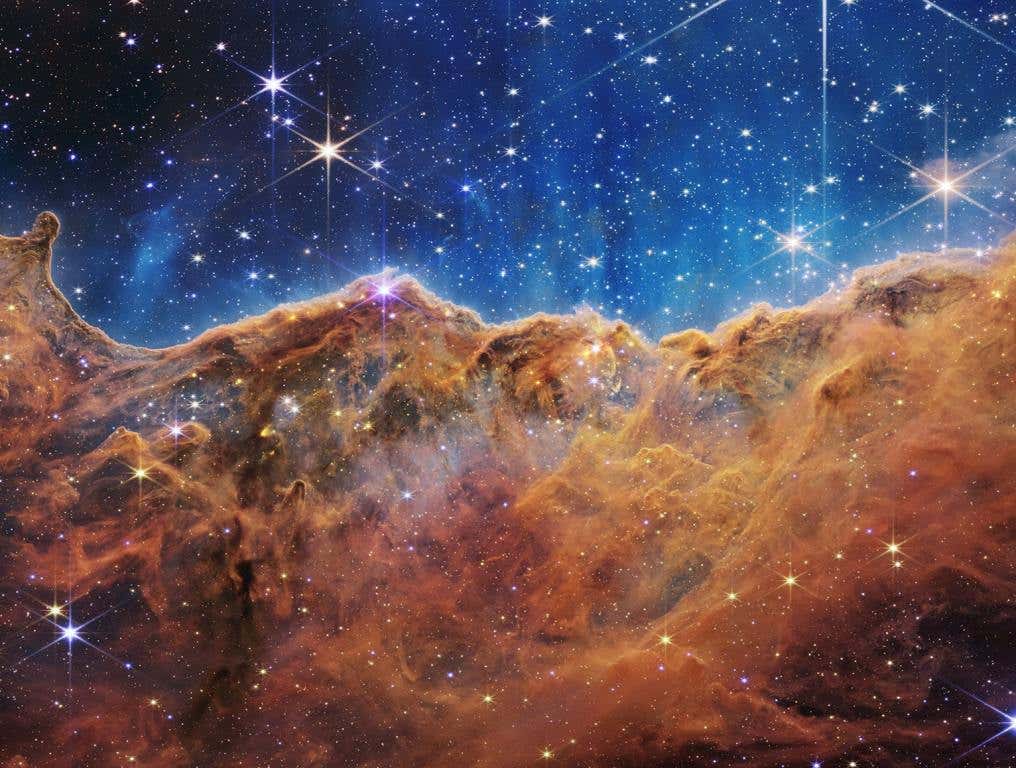
NASA unveiled stunning first images from the James Webb Space Telescope, including this infrared composite image of the Carina Nebula.
Image credit: NASA, ESA, CSA, and STScIWe've now seen some of the clearest and best images of deep space in human history, as NASA has released the first images from the James Webb Space Telescope.
The images were unveiled during a special event Tuesday (July 12) at NASA's Goddard Space Flight Center in Greenbelt, Maryland.
"This day gives a new meaning to as far as the eye can see," Rep. Steny Hoyer from Maryland said during a news conference. "The vision of the world is greater today than it was yesterday. It will renown to the benefit to all people of this Earth."
The four images released Tuesday included the Carina Nebula, the Southern Ring Nebula, Stephan's Quintet and spectrum of WASP 96-b. More on what all that means below.
NASA unveiled the first of five images in a sneak peek Monday night, with President Biden showing the First Deep Field image at a White House press briefing.
The Webb Telescope essentially looks back in time some 13.5 billion years. That's possible because of the distance many of these deep space objects are, and the amount of time it takes for light to travel from them to our eye.
For comparison sake, the James Webb Space Telescope sits about 1 million miles from Earth currently at a spot called "Lagrange Point 2." At the speed of light, Webb is essentially 1.7 light years from us right now. And the images it is sending are of images 13.5 BILLION light years away. The Sun is about 93 million miles away, and its light takes about 8.3 minutes to get to us.
Webb's journey to this point has been a long one. It launched from Earth on December 25, 2021 and took 30 days to get to its current location at Lagrange Point 2. That specific spot in space allows Webb to orbit at the same rate as Earth, giving it a sunscreen of sorts from its home planet.
The $10 billion project is designed to send it on a mission that will last 5 to 10 years. The project took 40 million total hours to build, including thousands of scientists, engineers and technicians from 14 countries and 29 U.S. states. It was first conceptualized starting in 1989, and construction began back in 2004.
Webb has spent the last few months going through cooldown, telescope alignment and other procedures allowing it to get ready for all its experiments.
We'll see spectacular releases from Webb frequently in the future. But for now, here's a look at the individual images unveiled Tuesday, representing the first to come from Webb.
Carina Nebula
The final image released during the event was probably the most visually spectacular. This Carina Nebula image shows a collection of stars and gas some 8,000 light years away - relatively close. The area shows stars we've never seen before, and even elements that scientists have never seen before, thanks to the infrared capabilities on Webb.
Every bright dot in the image is a star, many of which are similar to our Sun, so many of them also likely have similar planetary structures nearby.

Image credit: NASA, ESA, CSA, and STScI (Click on image for high resolution version.)
The Southern Ring Nebula
The second image released was of the Southern Ring Nebula.
"The Southern Ring nebula is a planetary nebula. (Despite “planet” in the name, these aren’t planets — they're shells of dust and gas shed by dying Sun-like stars.) The new details from Webb will transform our understanding of how stars evolve and influence their environments."

Some stars save the best for last. The dimmer star at the center of this scene has been sending out rings of gas and dust for thousands of years in all directions, and NASA’s James Webb Space Telescope has revealed for the first time that this star is cloaked in dust.
Stephan's Quintet
This image shows five giant galaxies, containing hundreds upon hundreds of billions of stars.
Four of the five galaxies visible are actually interacting with each other, while the fifth (the one on the left) is actually much closer to Earth, so is nowhere near the others.
There are 150 million pixels in this image, and it's actually a composite of about 1,000 image files.

Image credit: NASA, ESA, CSA, and STScI (Click image to see high resolution image.)
The First Image - Webb's First Deep Field

The first image from NASA's James Webb Space Telescope has been released, and it's a stunning look at a cluster of galaxies from 4.6 billion years ago. (<span style="color: #212124;">Credits: NASA, ESA, CSA, and STScI)</span>
"If you held a grain of sand up to the sky at arm’s length, that tiny speck is the size of Webb’s view in this image. Imagine — galaxies galore within a grain, including light from galaxies that traveled billions of years to us! Why do some of the galaxies in this image appear bent? The combined mass of this galaxy cluster acts as a “gravitational lens,” bending light rays from more distant galaxies behind it, magnifying them."
WASP-96b Exoplanet
The first new image released Tuesday was the spectrum of an extrasolar planet called WASP-96b. This is a planet that's roughly half the size of Jupiter, and the image is being released to showcase the science that Webb can do. So while it's not a cool "visual" image, there's a lot of incredible science in this.
"NASA’s James Webb Space Telescope has captured the distinct signature of water, along with evidence for clouds and haze, in the atmosphere surrounding a hot, puffy gas giant planet orbiting a distant Sun-like star," NASA said in a release. "The observation, which reveals the presence of specific gas molecules based on tiny decreases in the brightness of precise colors of light, is the most detailed of its kind to date, demonstrating Webb’s unprecedented ability to analyze atmospheres hundreds of light-years away."
Webb vs. Hubble
Webb's Deep Field

This image is a remarkable showcase of the Deep Field from the first Webb image, but in different waves of light.
"Compare Webb’s Mid-Infrared (L) & Near-Infrared (R) views. Lens flares? Nope, the spikes you see are when light from bright objects like stars is bent by the edges of the telescope. They’re less prominent in mid-infrared."





